(1912-2003)
This tremendously interesting painter had a most unusual background and broad experience and training. Constantin Kluge was born in Riga, Latvia, on January 29, 1912, of Russian parents. His father was a graduate of the Polytechnic Institute of Riga and his mother a Professor of Literature. Kluge’s father was drafted into the Czar’s army in 1914. Then the chaos of the 1917 Bolshevik Revolution and the ensuing Civil War completely uprooted the family. They moved frequently, always eastward, arriving in Manchuria in 1920. Here the little boy learned to speak Mandarin. In 1925 the émigré family moved again, this time to the French “concession” of Shanghai, where Kluge would graduate from the French Municipal High School. By the time he was seventeen, he was a very active member of the Shanghai Art Club. At this period of his life he also took up the violin and cello, and later in Paris gave music lessons to help meet his expenses. Meanwhile, his parents had decided that pure art was not a dependable career, and so in 1931 Kluge left Shanghai for Paris to study architecture. He spent six years at the L’ecole des Beaux-Arts and in 1937 graduated with the title of French Government Architect.
The years spent studying and living in the Latin Quarter of Paris had created in Kluge a strong attachment to the characteristic scenes of Paris, and, instead of returning immediately to Shanghai and his family, he stayed on in Paris for six months painting views of Paris in oils, purely to portray and preserve the scenes he so loved. The childhood years spent in the Orient had contributed to his love of painting. His professor of Chinese had taught him, from the age of ten, a respect for the handling of the brush, and the attitude of the Orientals toward the beauties of nature drew the young artist to the depiction of beauty and away from the vogue for the ugly and sordid in painting. When Kluge returned to China, he practiced his profession of architecture for a time. But when his friends persuaded him to exhibit his paintings, the exhibitions were so successful and aroused such enthusiasm that Kluge felt that painting, his first love, could afford him a livelihood. Kluge spent the years of World War II in Shanghai and was convinced that he avoided trouble with the Japanese occupiers only because of the respect and love the Japanese people have for painting.
In mid-1946 he accepted an architectural post in Hong Kong and continued to paint in his spare time. In March, 1950, amid rumors that the Chinese Communists might invade Hong Kong, Constantin Kluge left Asia for good and returned to his beloved Paris, Already a mature and successful painter by the time he reached Paris, it is not surprising that he won an award and considerable attention at the Paris Salon in 1951. Since that time he had been a frequent exhibitor in the Salon shows,which proved to be his gateways to ever increasing public attention, Kluge was a member of the Soci6te’ des Artistes Francais, and his works have won prizes at their Salon. In 1961 he was awarded the M6daille d’Argent as well as the special Raymond Perreau prize given by the Taylor Foundation at the Salon.
In 1962 he received the coveted Gold Medal of the Salon. In 1990, Kluge earned one of the most prestigious non-military awards bestowed by the French government: he was named a Chevalier de la Ugion d’Honneur by the French Ministry of Culture. In 1991, Kluge was awarded the Grand Medal of the City of Senlis. Completely captivated by the many moods of Paris, Kluge had become absorbed in painting this beautiful city. The gaiety and animation of the flower markets; the subtly pensive and poetic quiet areas along the Seine; the special quality of Paris sunshine in early spring; the quaintness yet sophistication of this Queen of Cities are wonderfully expressed in his widely varied compositions. His fascination with Paris was contagious and the viewer feels drawn into each Kluge painting. In addition to Paris proper, Kluge sought out quiet, picturesque harbor scenes where the colors of water and sails blend to form softly modulated patterns of great beauty and interest. As with his paintings along the Seine, Kluge’s handling of water in these harbor scenes is unusually lovely and convincing.
Probably due to his early architectural training, Kluge had in the past been primarily occupied with subjects which include buildings of many types, but pure landscape subjects intrigued him as well. In his country scenes of provincial France, where sunlight and changing atmospheric qualities present a new challenge, Kluge used the same subtlety and sensitive rendering of beauty found in his other work, It is interesting to find this capable painter rounding out his repertoire in such varied fashion. While Kluge continued to paint, he was also a writer of considerable stature, His autobiography, Constantin Kluge (published in 1987), details his fascinating life and includes many color reproductions of his paintings.
French art critics have declared that Constantin Kluge is a painter of poetic realism. Kluge painted without affectation, in a frank and straightforward style. His firm drawing and well-constructed forms are bathed in an atmosphere of subtle colors. He enjoyed painting and communicated that joy to the beholder.

